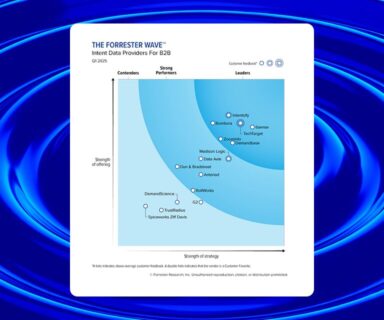 It’s 2022. You’ve created compelling display ads for a valuable product, but you’re struggling to reach the audience that needs it. You can’t identify potential buyers in a sea of generic internet impressions, and you’ve lost access to vital purchase intent activity insights. This scenario is now less than a year away, and many marketers are wondering how to evolve in a world without 3rd party cookies.
It’s 2022. You’ve created compelling display ads for a valuable product, but you’re struggling to reach the audience that needs it. You can’t identify potential buyers in a sea of generic internet impressions, and you’ve lost access to vital purchase intent activity insights. This scenario is now less than a year away, and many marketers are wondering how to evolve in a world without 3rd party cookies.
There are a lot of extremely technical solutions being discussed, but the prevailing feeling for marketers right now is still uncertainty. What trends should you be monitoring, and what can you do right now to prepare?
What are we really talking about?
1st party cookies are vital to businesses to maintain customer login information, track analytics data and create a positive user experience on their website. This is like the loyalty program at your grocery store. Understanding who you are, and your past purchases, lets them customize coupons, deliver discounts and email you a receipt.
3rd party cookies are effectively the same snippet of code, but one that was put on your browser by a website that is different from the one you are currently visiting. So, 1st party cookies from a website immediately become 3rd party cookies once you leave. Websites also partner with other companies to allow them to place 3rd party cookies on users’ browsers to gather information.
Websites access all the 3rd party cookies on your browser to get a full picture of who you are, where you’ve been and what you like. Imagine your local grocery store, instead of just scanning your card, opens your wallet and reads through your driver’s license, receipts and other membership cards to understand your past activity and intent.
By eliminating 3rd party cookies, Google wants to prevent websites from accessing that data to protect user privacy. As a result, they’re shutting down insights into a person’s demographics, interests and previous activities available to ad targeting platforms. While it remains to be seen how successful that will be, we do know that eliminating 3rd party cookies effectively crumbles the current foundation of programmatic ad targeting.
Unification… but will it work?
Trying to get a grasp of Google’s intent once cookies are phased out is difficult, especially when Google isn’t exactly clear on what they will be doing. To address the issue head-on, several companies are creating non-cookie-based solutions that replicate the targeting features ushered in by cookies.
Companies like The Trade Desk along with organizations like PRAM (the Partnership for Responsible Addressable Media) and the IAB Tech Lab are working on open-source solutions featuring unified identifiers (UID 2.0). These are email-based identity associations used to create more accurate targeting to users who have consented to have their data included.
Going back to our grocery store analogy, this is like a group of stores partnering to share the data from their loyalty programs to maintain insight into what their customers are doing – even when they aren’t physically in their store.
The ability to understand and target specific users – known as addressability – would live on, but in a fractured form. There’s still debate over which identifier would reign supreme with the likely outcome of a series of identifiers applicable within their own playgrounds – with little to no communication between them. This again leaves the marketer trying to pick up the pieces to see the full picture of their campaigns.
Google further ruffled feathers by saying they are not going to be using alternative ways to track users. Their stance is that replicating cookie-type behavior using user emails – even if consent was given – will not fly. While not directly stated, this was a clear shot at unified identifiers being the solution the industry needs.
Unified identifiers are for the birds – Google’s FLoC plan moving forward
If Google’s out on unified identifiers, what do they expect to fill the massive void left by 3rd party cookies? There have been numerous proposals from their Privacy Sandbox, but they’ve most recently settled on FLoC (Federated Learning of Cohorts).This replaces individual identifiers with a system that places users into common interest groups. Those groups would be targetable, and the data would be reported at the group level – not the individual level.
Imagine Google looking through everyone’s wallets to understand their activity, then grouping similar profiles together – all while not sharing the full data pictures with the stores where the activity occurs.
Google claims that FLoC will be 95% effective at replicating the performance seen with campaigns targeted using 3rd party cookies, but not everyone is convinced. Without seeing the specific data, a lot of uncertainty remains.
Is Google saying what is good for the goose is not exactly good for the gander? It is too early to say, but they would continue to have access to all that data while it remained anonymous for everyone else.
Where does that leave you?
While it’s important to keep tabs on potential cookie-targeting replacement solutions, it’s not necessary to get an up-close look at how the sausage is made at this point. These solutions will eventually be known prior to 3rd party cookies’ demise. Right now, there are three things you can focus on to prepare for the shift:
- Maintain an integrated advertising approach across-media to support your multi-channel engagement efforts.
- Ramp up first-party data collection and cleansing in your database.
- Identify and engage trusted publishers to ensure you can target your audience contextually regardless of the cookie replacements.
Build brand confidence with integrated marketing campaigns
Without 3rd party cookies, tracking down IT buyers can be tedious, so knowing where they research buying decisions is key. Developing an integrated marketing strategy enables you to create a consistent experience with your brand by using cross-channel campaigns to maximize your impact on customers.
We all know the saying; two heads are better than one. Well, the same goes for your marketing campaigns. If you are running a multi-channel campaign, you create more opportunity to influence a larger audience. At the same time, your goal is to find the right audience. It’s in your best interest to build campaigns that resonate with your audience and flow seamlessly from touchpoint to touchpoint, increasing the opportunity for engagement.
Integrated campaigns connect the dots. From traditional to digital, all these mediums work in unison to create more 1st party data and visibility outside of cookie targeting. That will help you build trust, stay top of mind and quicken the time for leads to convert.
Build a powerful database
1st party data is like gold in a cookieless world. Your data is one of your company’s most valuable assets. Building upon 1st party data you have in your CRM will be instrumental in this transition period.
Capturing pertinent data right from the start will give you a better understanding of your customer relationships and how they engage with your company thoughout the funnel.
1st party data will endure the demise of 3rd party cookies. It will continue to provide both marketing and sales with valuable insights that can connect them to the right IT buyers and when they are ready to buy. It will also be the key to unlocking targeted reach and scale with any unified identifier solutions that gain traction. If 1st party data is the price of targeting admission, you need the data that will get you into the VIP room.
Develop relationships with a trusted partner
With the clock ticking, it’s time to find a publisher that can best reach and engage your audience. But how do you find the right one? Aligning your creative with trusted content provides quality brand impact within highly contextual environments, to make sure the right IT buyers find you. Forging a strong partnership with a technology publisher will open the door to accurate targeting and tangible intent signals. This creates efficient access to your target audience and helps further influence buyers. The right technology publisher will unlock access to their 1st party data to fully support your display advertising needs after 3rd party cookies are phased out.
The end of cookies does not signify the end of targeted audience segments. It just means that marketers must seek out alternative solutions to meet marketing objectives. As the industry continues to sort out what that will look like, now is the time to take steps to include integrated advertising across media channels, improve the quality of data you have in your CRM and build relationships with trusted publishers.




